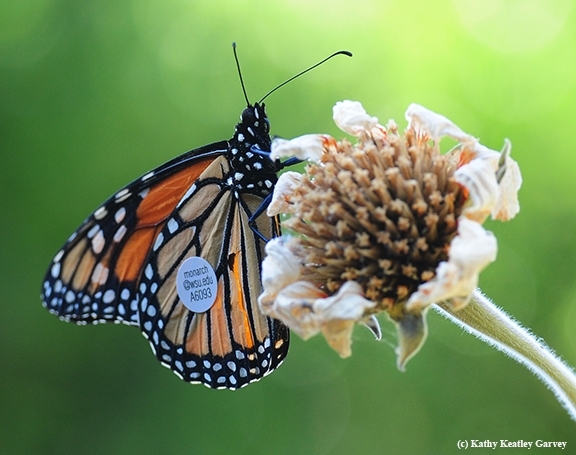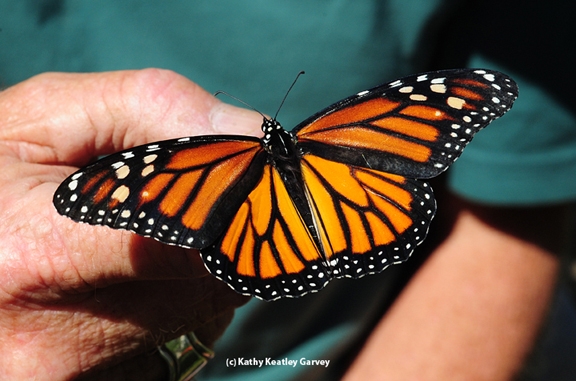- Author: Kathy Keatley Garvey

Be on the lookout for migratory Monarch butterflies from the Pacific Northwest heading south to their overwintering sites along the California coast.
It's been a very good year for Monarchs in the Pacific Northwest (PNW), according to noted entomologist and Monarch researcher David James, an associate professor at Washington State University (WSU), Pullman.
"The numbers we are seeing in the PNW this summer are consistent with numbers I've seen in summers past when the overwintering population was approximately 250,000 as it was last winter," he wrote in an email Aug. 31.
"I have been compiling all the PNW monarch reports I have come across this summer--as I have done for many summers in the past. These have been from iNaturalist, Journey North, various Monarch Facebook pages and personal communications I get many people telling me they've seen a monarch. I verify all reports, that is, they must have a photo, or I know the reporter is experienced."
"Last summer (2021) I verified approximately 60 Monarch sightings in the PNW. This summer, I have had approximately 500 verified reports. "So, I think we have seen an 8-10 fold increase in Monarch numbers this summer in the PNW. The majority have been in Oregon, followed by Idaho, Washington and British Columbia. There are also positive reports of good numbers of Monarchs in Utah, Nevada and eastern California."
"So the signs are there for a good migration back to California this fall," James said. "The big question will be whether the migrants proceed normally to the overwintering sites or whether they do what they did in 2020, establish winter breeding populations in slightly inland places like San Francisco and Los Angeles. The determining factor will be the temperatures California experiences over the next six weeks. If average temperatures prevail, then the butterflies will go to the coastal overwintering sites and we will have--I think--spectacular numbers again...at least as high as last year and possibly much higher."
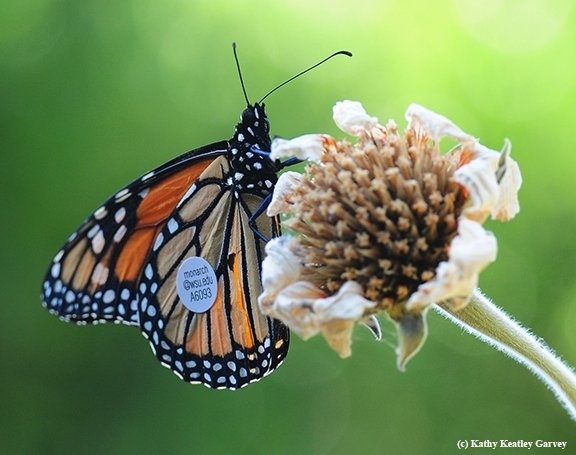
To track migratory Monarchs, citizen scientists in the David James' research program affix a tag on the discal cell (underside of the hind wing). The tag does not interfere with its flight.
This year James handed out 2000 tags to citizen scientists in southern Oregon.
One of his citizen scientists, Steve Anderson of Ashland, Ore., tagged a male Monarch on Aug. 28, 2016 that stopped for nectar in our Vacaville pollinator garden on Sept. 5, 2016. The tag read “Monarch@wsu.edu A6093." It hung around for five hours. (See Bug Squad blog and WSU news story)
"So, assuming it didn't travel much on the day you saw it, it flew 285 miles in 7 days or about 40.7 miles per day," James told us back in 2016. "Pretty amazing. So, I doubt he broke his journey for much more than the five hours you watched him--he could be 100 miles further south by now."
This year, to date, we have not seen a single Monarch in our pollinator garden. James estimates we will start seeing the first ones within the next few weeks. "Johnson has already had one of his tagged monarchs recovered, admittedly only a few miles away but it was heading south!"
Butterfly guru Art Shapiro, UC Davis distinguished professor of evolution and ecology, spotted four within half an hour in the UC Davis Arboretum and Public Garden on Aug. 26. One was a tattered male. (See Bug Squad blog)
What to do if you see a WSU-tagged Monarch? Photograph it, if you can, and contact David James at david_james@wsu.edu or the PNW Facebook page. Also, report any Monarch sightings to iNaturalist and Journey North.
Meanwhile, Monarch scientists, citizen scientists and Monarch enthusiasts are looking forward to the 2023 International Western Monarch Summit, set Friday through Sunday, Jan. 20-22 at Pismo Beach, San Luis Obispo. Registration is now underway. It's sponsored by Western Monarch Advocates (WMA), which relates its mission is "to serve as an overarching entity to encourage and facilitate communication and interaction of groups and individuals committed to restoring the western monarch butterfly population-regardless of their affiliation or location--in the hope that the shared knowledge will empower each of them to improve and better achieve restoration goals within their own respective affiliation or location."
The International Union for the Conservation of Nature (IUCN) placed the migratory monarch butterfly on its Red List of threatened species on July 21, 2022, classifying it as endangered.
"In the 1990s, nearly 700 million monarchs made the epic flight each fall from the northern plains of the U.S. and Canada to sites in the oyamel fir forests north of Mexico City, and more than one million monarchs overwintered in forested groves on the California Coast," according to the Xerces Society for Invertebrate Conservation. "Now, researchers and citizen scientists estimate that only a fraction of the population remains, monarchs have declined by more than 80% since the 1990s from central Mexico, and by more than 99% since the 1980s in coastal California."
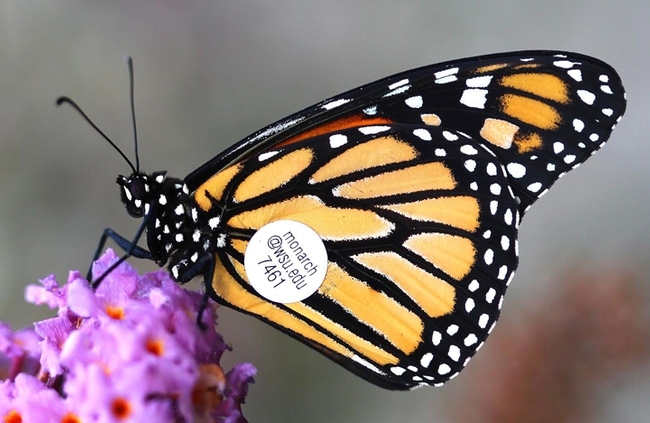
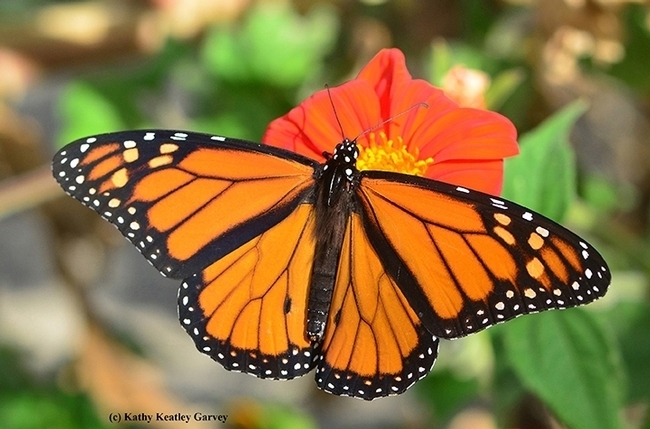
- Author: Kathy Keatley Garvey
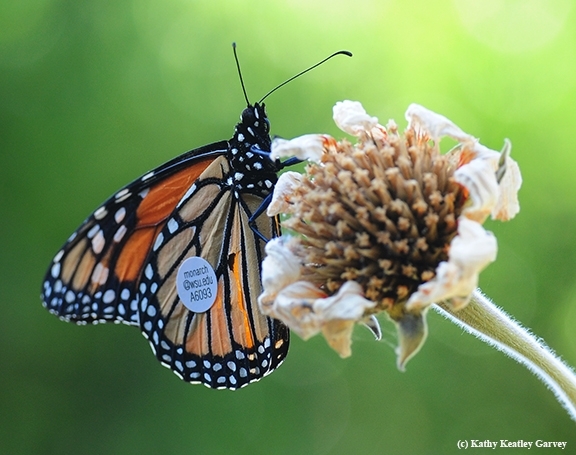
Our little pollinator garden in Vacaville, Calif., usually draws dozens of them in the summer as they flutter around, sip nectar from the Mexican sunflower (Tithonia) and lay their eggs on their host plant, milkweed.
Then in late summer and fall, the migratory monarchs from the Pacific Northwest pass through on their way to their overwintering sites in coastal California, including Pacific Grove and Santa Cruz.
But...
Something is happening this year, and it's not good.
As a "monarch mom," I reared and released more than 60 in 2016. This year so far: zero, zip, zilch. In fact, I never saw a single monarch in our pollinator garden this year until Monday, Aug. 13, and then again today (Friday, Aug. 30) when a male fluttered in and hung around for several hours.
This time last year and in 2016? Often five to seven sightings a day.
"What's going on with the monarchs?" I asked butterfly expert Art Shapiro, UC Davis distinguished professor of evolution and ecology, who has monitored the butterfly population in central California for more than four decades and maintains a research website. "All I have on our milkweed are aphids and milkweed bugs, and occasional bees and hover flies."
I also haven't seen a single monarch on the UC Davis campus. Neither have fellow photographers and naturalists who keep an eye out for them.
Background: Shapiro has been surveying fixed routes at 10 sites at approximately two-week intervals since 1972. They range from "the Sacramento River delta, through the Sacramento Valley and Sierra Nevada mountains, to the high desert of the western Great Basin." As he says on his website, "the sites represent the great biological, geological, and climatological diversity of central California." As of the end of 2006, he has logged "5476 site-visits and tallied approximately 83,000 individual records of 159 butterfly species and subspecies. This major effort is continuing and represents the world's largest dataset of intensive site-specific data on butterfly populations collected by one person under a strict protocol. We have also collated monthly climate records for the entire study period from weather stations along the transect."
So, what's going on with the monarchs?
"You are not alone (in not sighting them)," he related in an email yesterday. "I have seen one adult monarch in the Valley in the past five weeks (and about 6 in the Sierra, migrating westward). I have not seen a single wild larva in 2018. Anywhere! Everybody's talking about it. We know there was some breeding at Fallon, Nev., but only a couple of adults have been seen in Reno. Either they are breeding in recondite places, which is possible, or the population is in serious collapse. We will know which by early November when we see what shows up at the overwintering sites. One thing is certain: it's not due to milkweed shortage!"
The statistics on his Looking Backward section of his website indicate these monarch sightings:
- 2015: 100
- 2016: 64
- 2017: 54
- 2018: 20
Note that this is the time of year when citizen scientists in entomologist David James' migratory monarch research program at Washington State University (my alma mater) tag and release them throughout much of the Pacific Northwest. (See Bug Squad)
They should be passing through our area soon. In fact, the third anniversary of "The WSU Traveler" is rapidly approaching: On Labor Day, Sept. 5, 2016, one of the tagged butterflies from James' citizen scientist program in Ashland, Ore., fluttered into our yard (see above photograph). The monarch, a male, hung around for five hours, sipping nectaring and circling around.
The background: Citizen scientist Steven Johnson of Ashland tagged and released the male, No. A6093, on Sunday, Aug. 28. It "flew 285 miles in 7 days or about 40.7 miles per day," James told us. "Pretty amazing. So, I doubt he broke his journey for much more than the five hours you watched him--he could be 100 miles further south by now. Clearly this male is on his way to an overwintering colony and it's possible we may sight him again during the winter in Santa Cruz or Pacific Grove!”
Maybe we'll see another tagged one this year? The odds do not look good.
As the WSU Facebook page, Monarch Butterflies in the Pacific Northwest, related today:
"While the migration from the PNW (Pacific Northwest) to California has been underway for about 2 weeks, September is when it really ramps up. Unlike the migration in eastern USA this year, our migration is subtle and comprised of much smaller numbers of butterflies. In fact there will be very few Monarchs migrating south from British Columbia, Washington and northern Idaho because we simply did not have significant summer populations in these areas this year. However, our research-based WSU breeding/tagging program will result in hundreds of tagged Monarchs migrating from various parts of Washington State. Apart from the celebrated Washington State Penitentiary tagging program, this year we also have more than 30 members of Cowiche Canyon Conservancy (Yakima) and the Washington Butterfly Association (Seattle, Spokane) each rearing and tagging small numbers of Monarchs. The first tagged Monarchs from this program were released yesterday (August 30) so watch out for them as they head south! And please be ready to capture an image on your phone that you can email to us."
So, if you see a tagged monarch butterfly from the WSU program, kindly photograph it and send the information to David James and his fellow researchers at monarch@wsu.edu.
Every sighting helps.
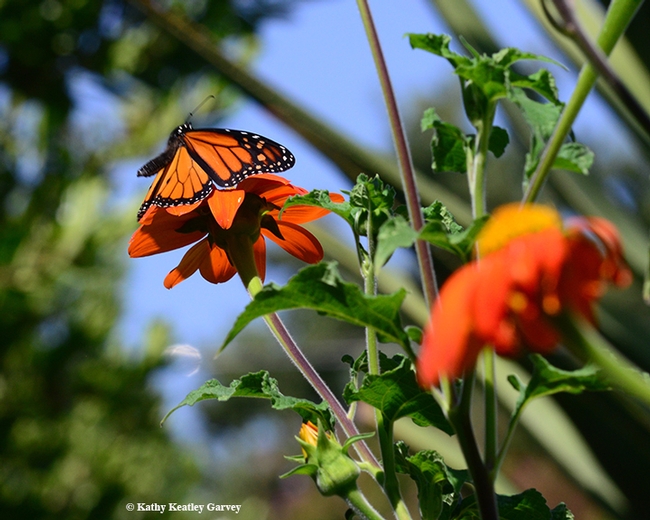
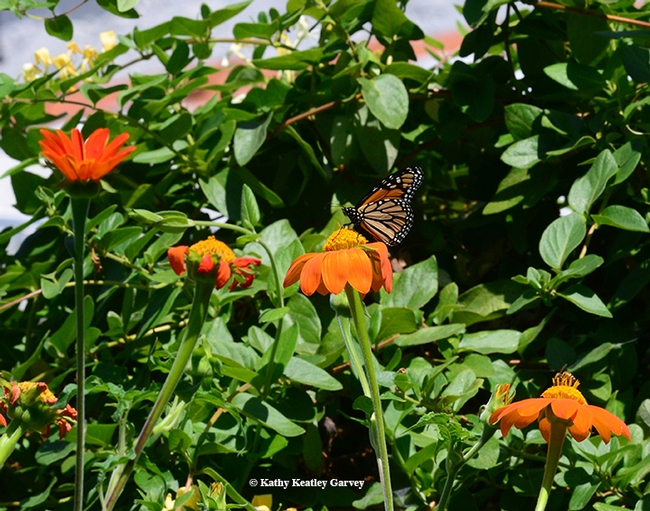
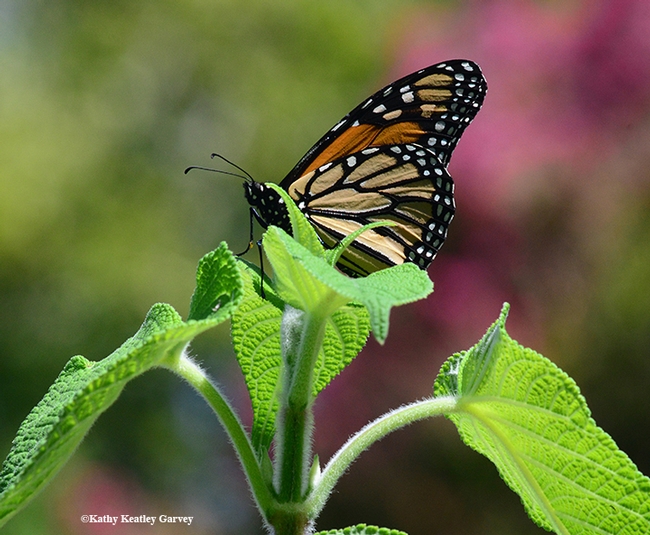
- Author: Kathy Keatley Garvey

They're on their way.
Camera ready? Check. Notebook ready? Check!
Entomologist David James of Washington State University, Pullman, Wash., who studies the migration routes and overwintering sites of the Pacific Northwest monarch population, told us last Friday, Aug. 25: "Many monarchs have been/are being tagged in Southern Oregon! One has already been recovered showing southern movement, so its likely they will be heading your way very soon!" He maintains a network of Pacific Northwest citizen scientists who rear, tag and release monarchs.
Last year on Sept. 5, Labor Day, a tagged monarch--a male--from his citizen scientist program in Ashland, Ore., fluttered into our yard in Vacaville, Calif. for a five-hour "pit stop" on his way to an overwintering site, probably in Santa Cruz or Pacific Grove. We followed him around, watching him sip nectar from Mexican sunflowers and butterfly bushes. Then we contacted James, sending him photos and information, and wrote about the encounter on a Bug Squad blog.
The tag read "monarch@wsu.edu," and serial number "A6093," which tied the butterfly to Ashland citizen scientist Steve Johnson of the Southern Oregon Monarchs Advocates (SOMA). Johnson tagged and released "A6093" on Sunday, Aug. 28.
"So, assuming it didn't travel much on the day you saw it, it flew 285 miles in 7 days or about 40.7 miles per day," James related. "Pretty amazing. So, I doubt he broke his journey for much more than the five hours you watched him--he could be 100 miles further south by now. Clearly, this male is on his way to an overwintering colony and it's possible we may sight him again during the winter in Santa Cruz or Pacific Grove!”
As far as we know, the Ashland reared-and-released monarch wasn't sighted again.
Fast forward to this year. We are seeing fewer monarchs this year than last. Last year we reared and released 60 monarchs in our small-scale monarch program. This season, however, we've noticed a drastic drop in the number of visitors to our pollinator garden, which includes plenty of milkweed, their host plant, and even more nectar sources. So far we've reared and released only four monarchs--three females and a male. Four chrysalids remain.
"Yes, it's been a dismal year for monarchs in many areas of the West, unfortunately," James wrote in an email on Aug. 29. "I think it stems from the late winter storms that hit the California coast just as the overwintering colonies were beginning to disperse... I think the survivors that produced the first spring generation of larvae were fewer in number than 'normal.' Consequently, the next generation (that begins migrating into the Pacific Northwest) was also smaller than usual. Many areas of the PNW had very few monarchs this year."
The good news, though, the associate professor said, is "that where monarchs did colonize in Washington, Idaho and Oregon, they had good breeding success, resulting in locally 'normal' or above normal sized summer populations. So I'm expecting an overwintering population comparable to last year. Thus, you should see a definite increase in numbers of monarchs coming through your yard over the next month!"
We hope so! Meanwhile, keep a lookout for those WSU-tagged monarchs. If you see one, try to photograph it and mail the image and information to David James at monarch@wsu.edu.
